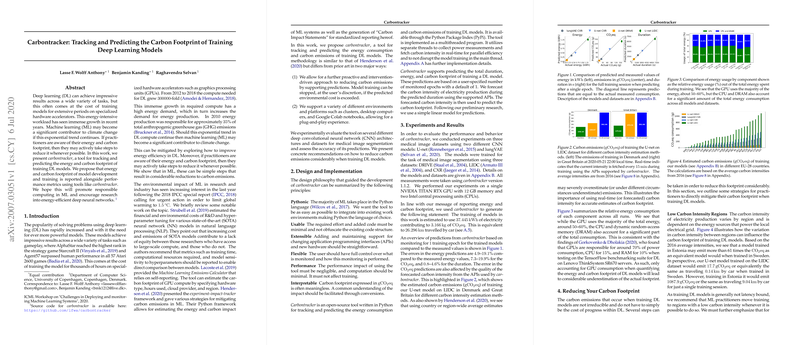An Overview of Carbontracker: Monitoring the Environmental Impact of Deep Learning
The paper "Carbontracker: Tracking and Predicting the Carbon Footprint of Training Deep Learning Models" by Lasse F. Wolff Anthony, Benjamin Kanding, and Raghavendra Selvan addresses an increasingly pertinent issue in the field of ML and deep learning (DL): the environmental impact of model training. As computational demands escalate in pursuit of advanced DL models, the corresponding energy requirements and carbon emissions rise significantly. This paper presents a pragmatic approach to quantifying and potentially mitigating these environmental impacts through the development of the tool, Carbontracker.
Methodological Contributions
Carbontracker is designed to measure, predict, and report the energy consumption and carbon emissions associated with training DL models. The tool integrates seamlessly into existing ML workflows, particularly within the Python programming environment, allowing researchers to incorporate it with minimal disruption. Its key features include:
- Energy and Carbon Footprint Monitoring: Carbontracker captures real-time power usage data for GPUs, CPUs, and DRAM, integrating comprehensive system energy consumption data.
- Proactive Prediction Mechanism: The tool forecasts the duration, energy consumption, and carbon emissions of a training session based on initial epoch data. This feature allows users to terminate or adjust experiments preemptively if predefined environmental cost thresholds are exceeded.
- Compatibility and Extensibility: Carbontracker supports multiple computational environments, including clusters and Google Colab, facilitating broad adoption across different research contexts.
- Real-time Carbon Intensity Data: By utilizing APIs to fetch real-time electricity carbon intensity data, Carbontracker provides more accurate estimates of the carbon footprint, accounting for temporal and regional variations in energy sources.
Experimental Evaluation and Results
The authors conducted experiments using Carbontracker on various Convolutional Neural Network (CNN) architectures and medical image datasets. They demonstrated that predictions on energy consumption could achieve errors as low as 4.9\% for energy estimates and 7.3\% for carbon emissions when comparing predicted to actual values. Such precision underscores Carbontracker's utility in providing actionable insights into the environmental cost of model training.
Moreover, the analysis detailed in the paper reveals the significant portion of energy consumption attributable to components beyond GPUs, particularly CPUs and DRAM. This insight challenges the common perception that GPUs are the sole contributors to energy footprint in DL tasks, highlighting the need for comprehensive monitoring.
Implications and Recommendations
Carbontracker's introduction into the DL pipeline has both practical and theoretical implications. Practically, it encourages ML practitioners to adopt more sustainable research practices by making informed decisions about training locations and durations, selecting efficient algorithms, and utilizing energy-efficient hardware. The authors emphasize the potential carbon emission reductions achievable by training models in regions with low carbon intensity or during periods of low demand, leveraging the tool's capability to make region-specific predictions.
Theoretically, the paper promotes a paradigm shift in how DL research success is measured. Traditionally dominated by performance metrics such as accuracy and efficiency, the inclusion of energy and carbon footprint metrics could engender a more holistic evaluation of DL systems. Such a shift could drive the research community to innovate toward more energy-efficient models, thus contributing to mitigating climate change impacts associated with rising computational demands.
Future Directions
As DL projects' scale and complexity increase, so too do the associated environmental costs. The paper advocates for widespread implementation of tools like Carbontracker to promote transparency and accountability within the ML community. Future work could further optimize prediction models, expand compatibility with non-NVIDIA hardware, and incorporate lifecycle analysis components to account for manufacturing and operational energy costs.
In conclusion, the tool presented in the paper is a crucial step toward sustainable AI research practices. It offers detailed insights into the environmental cost of DL tasks, aiding practitioners in making data-driven decisions that align performance with sustainability goals. As the field of DL continues to expand, incorporating tools for monitoring energy and carbon footprints will be vital in balancing technological advancements with environmental stewardship.
